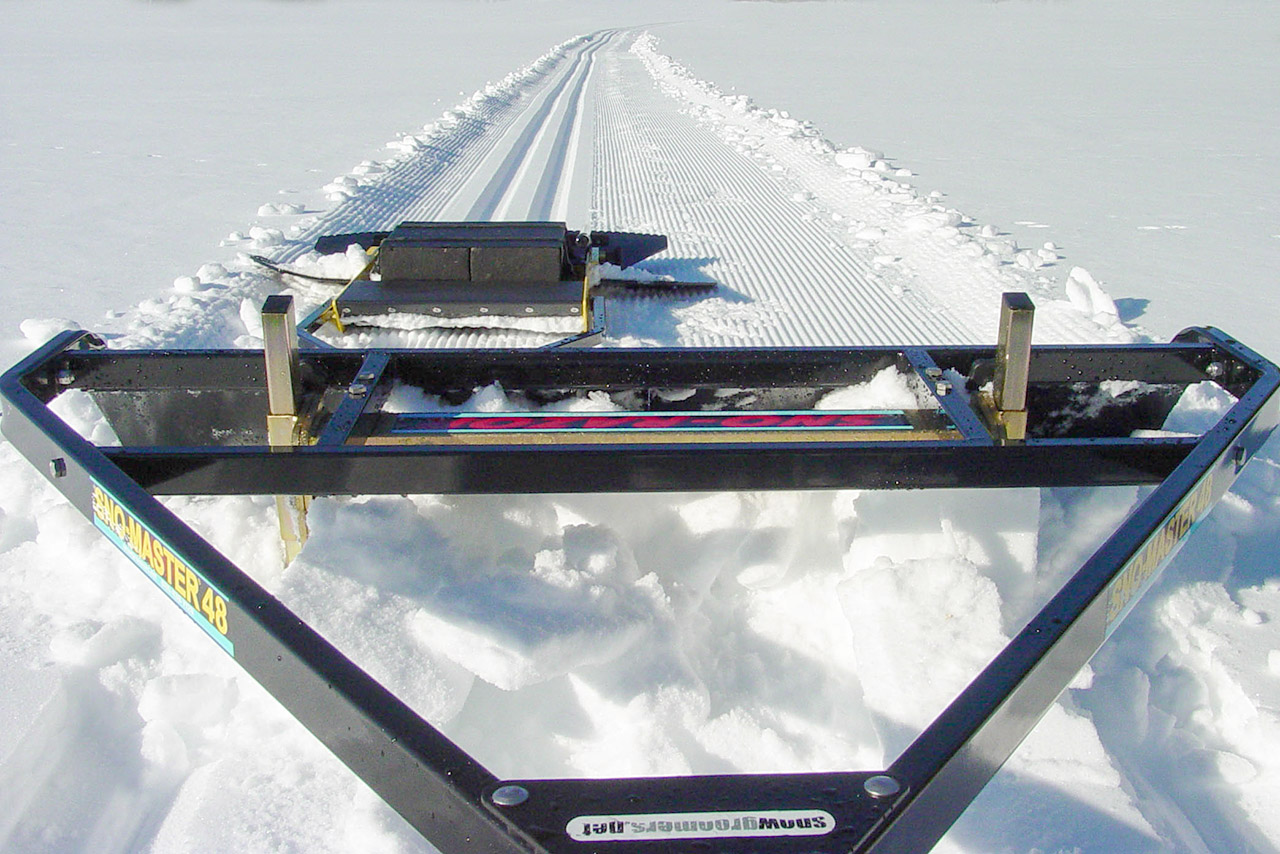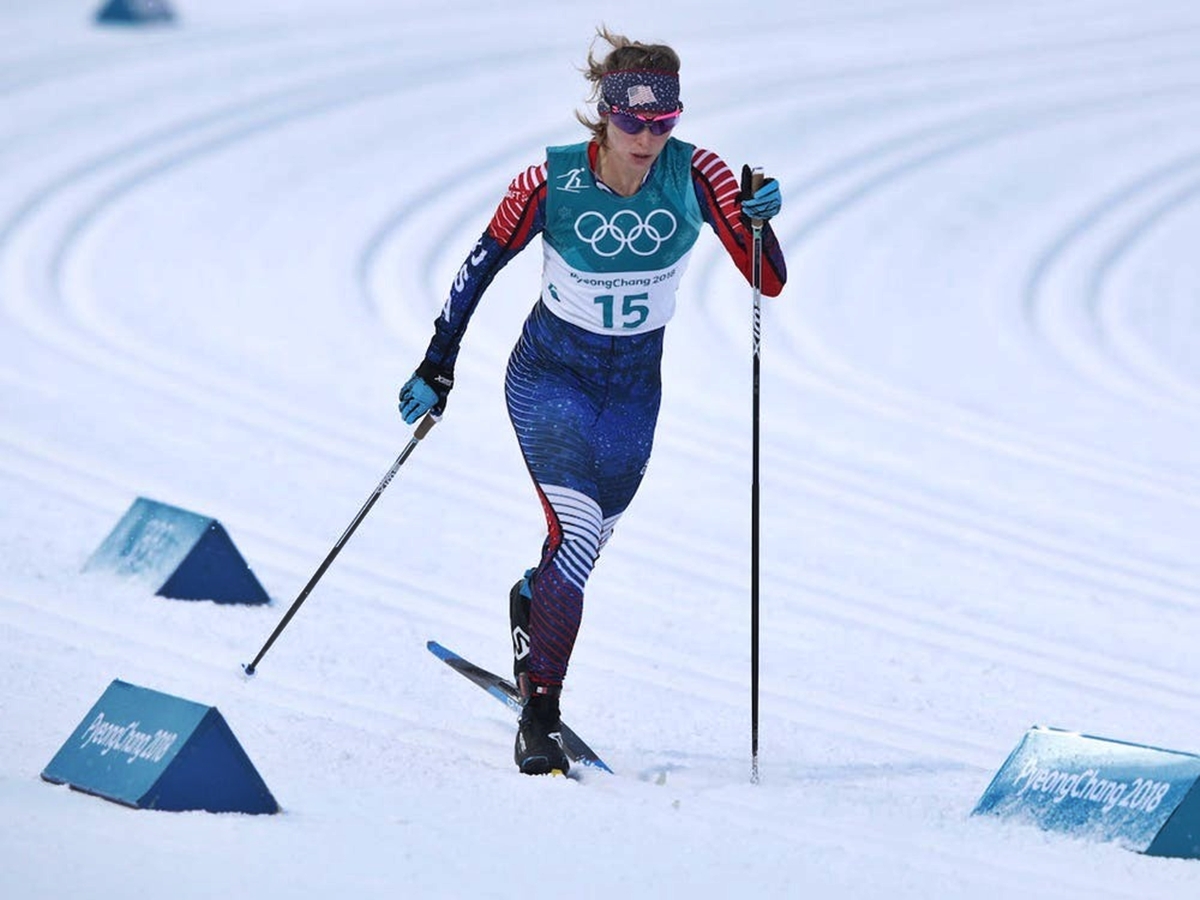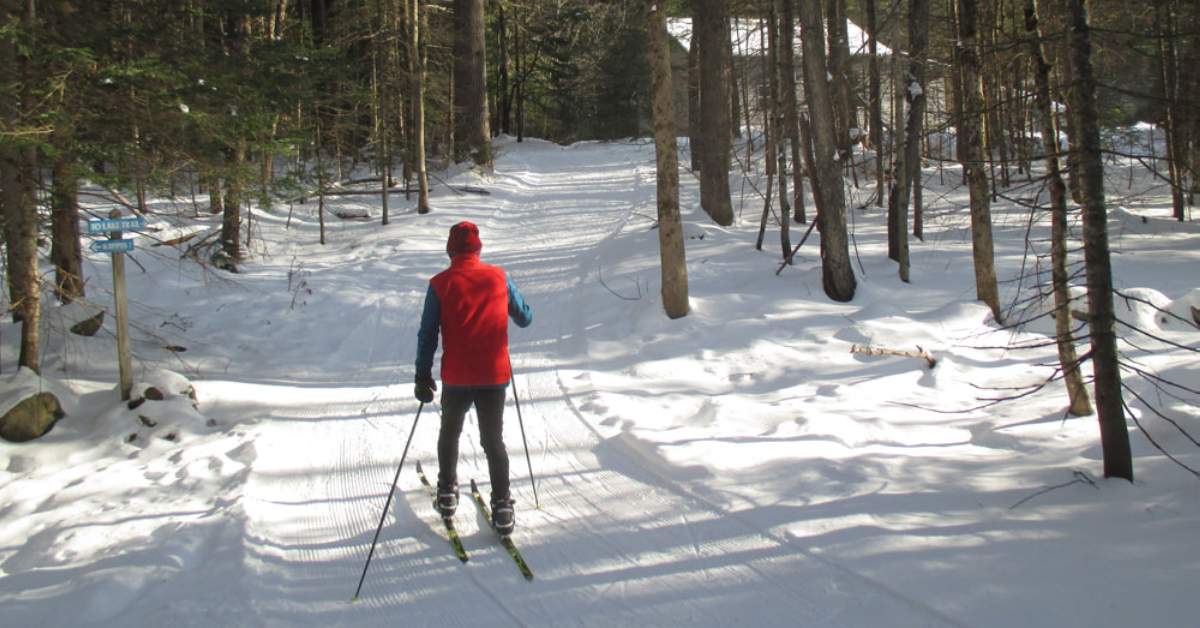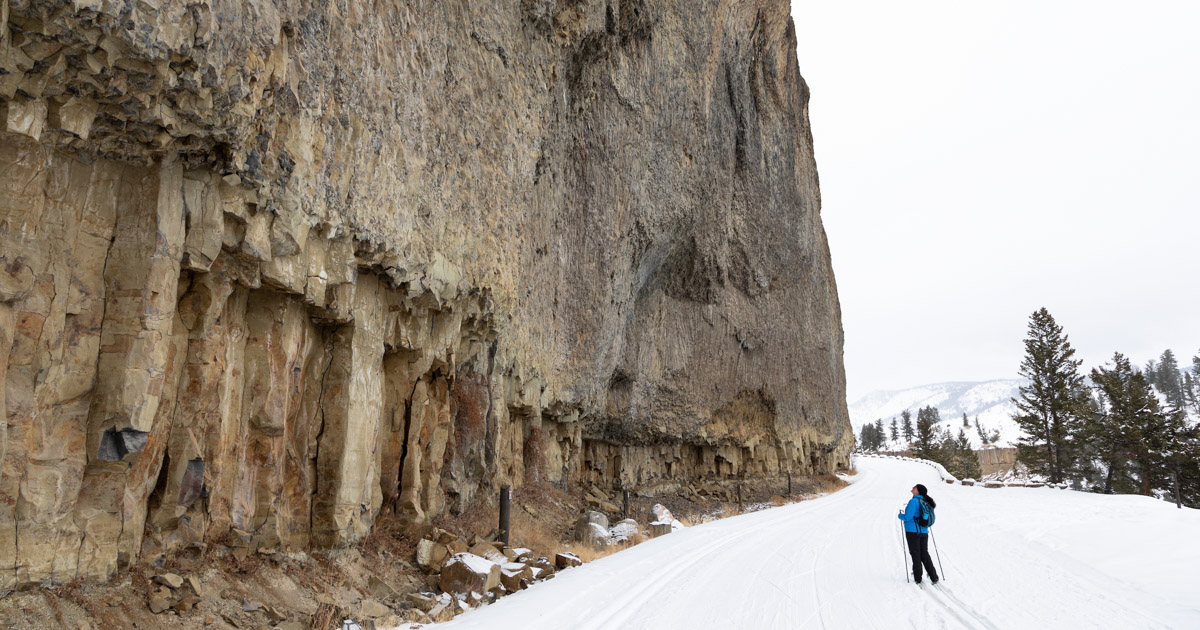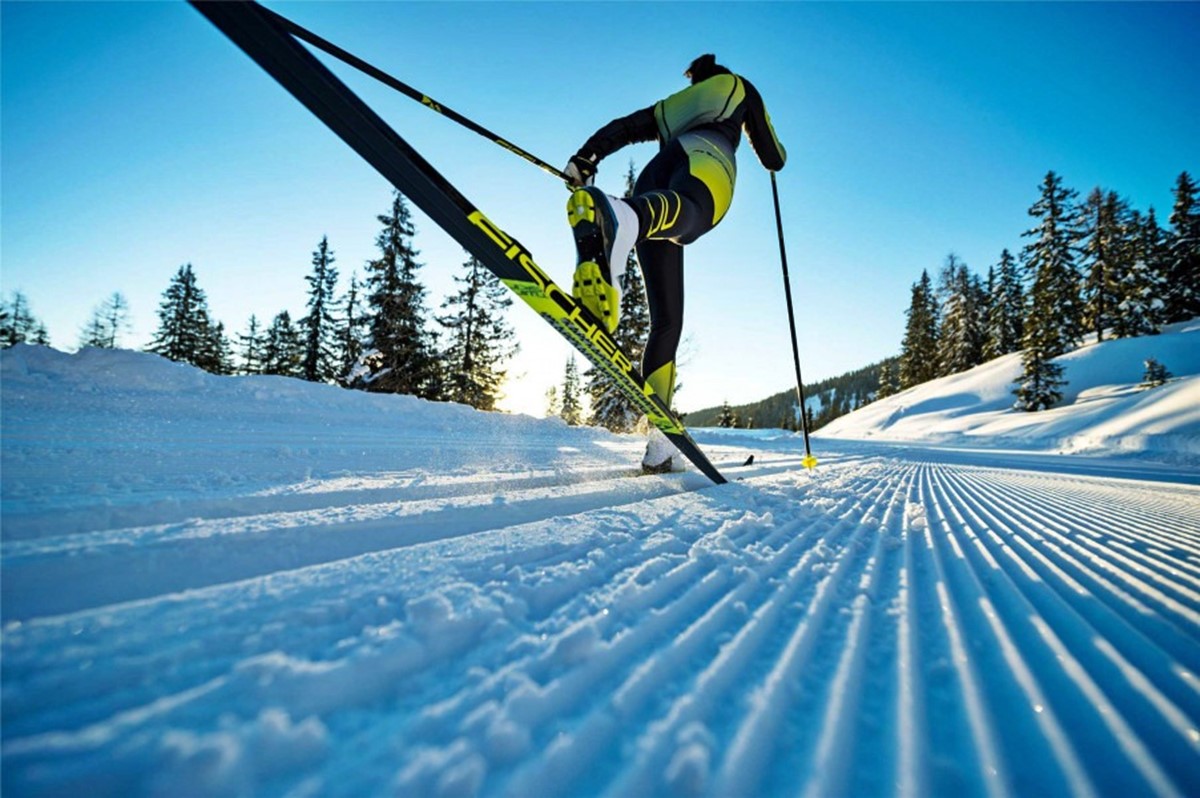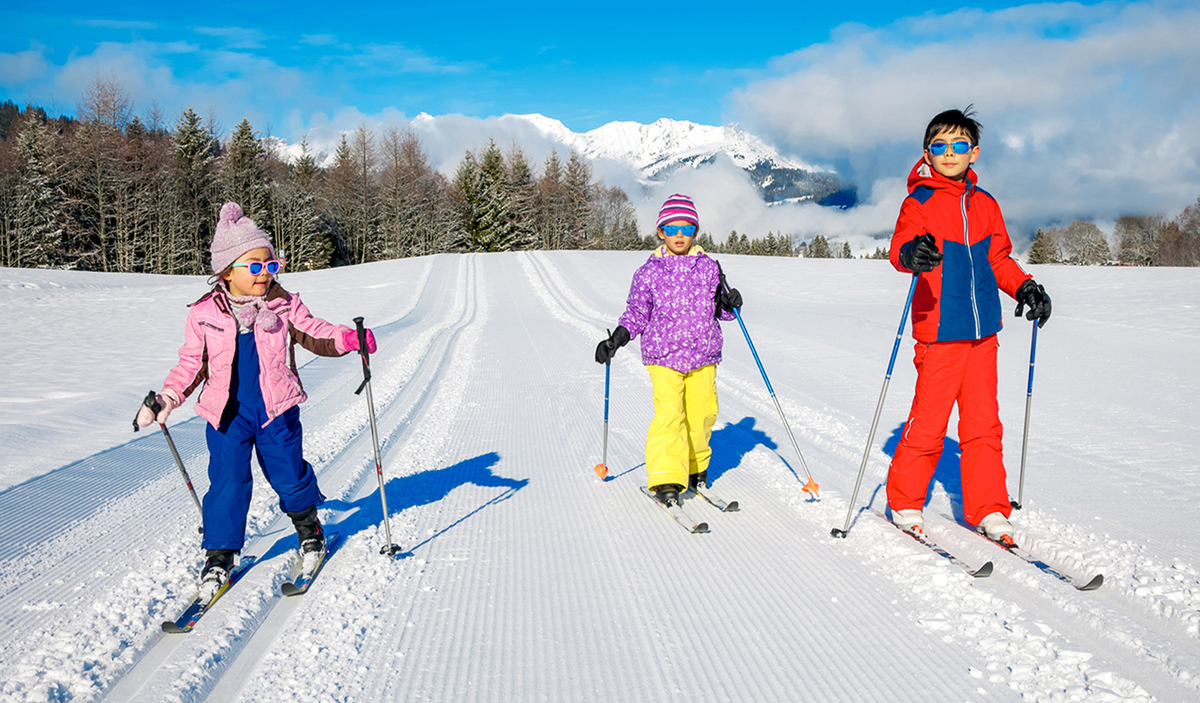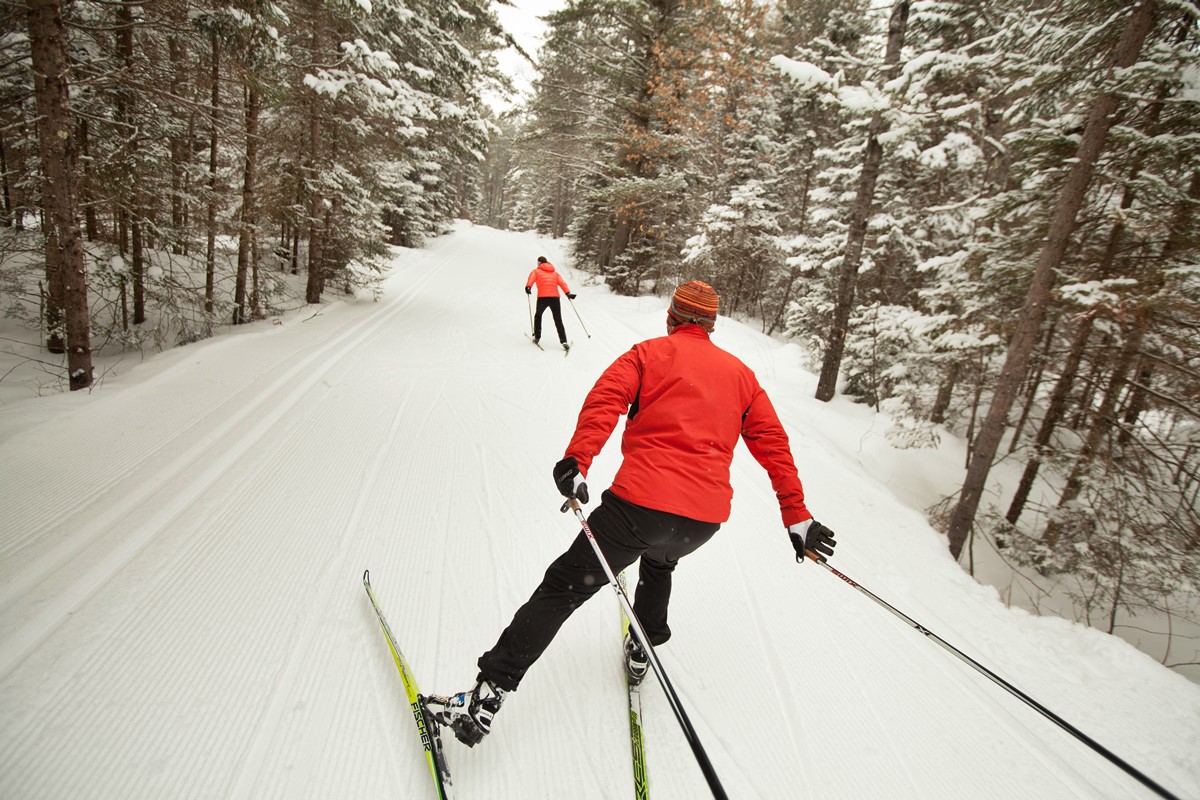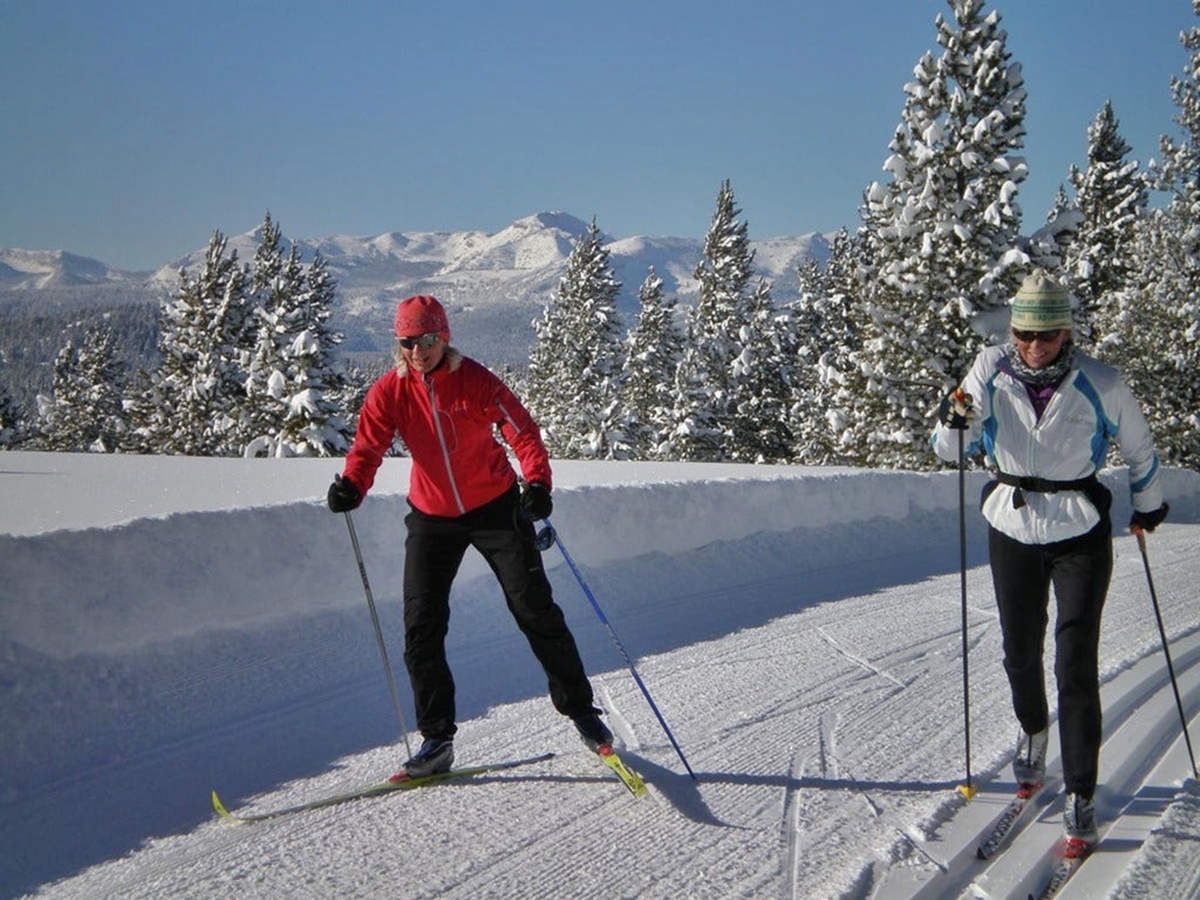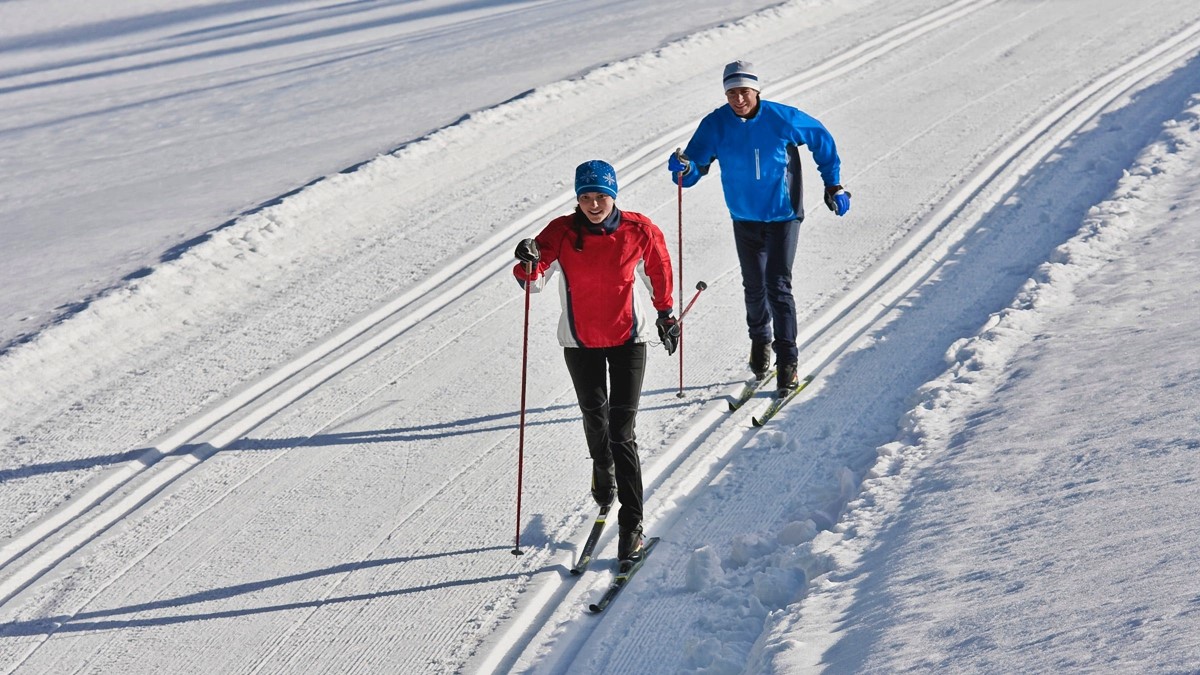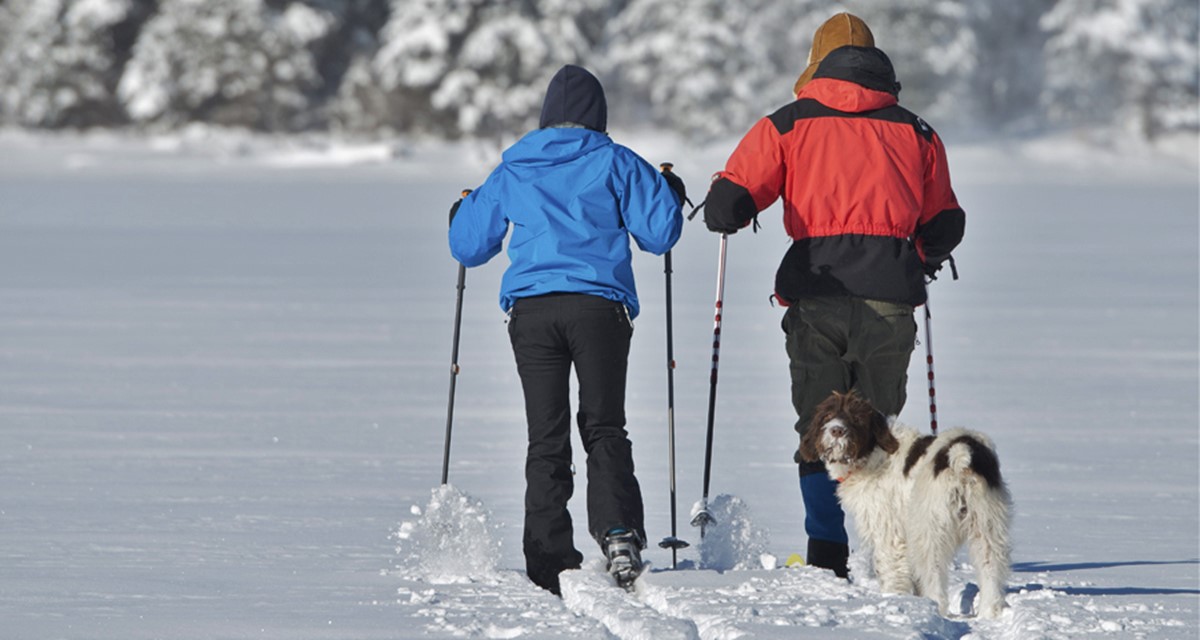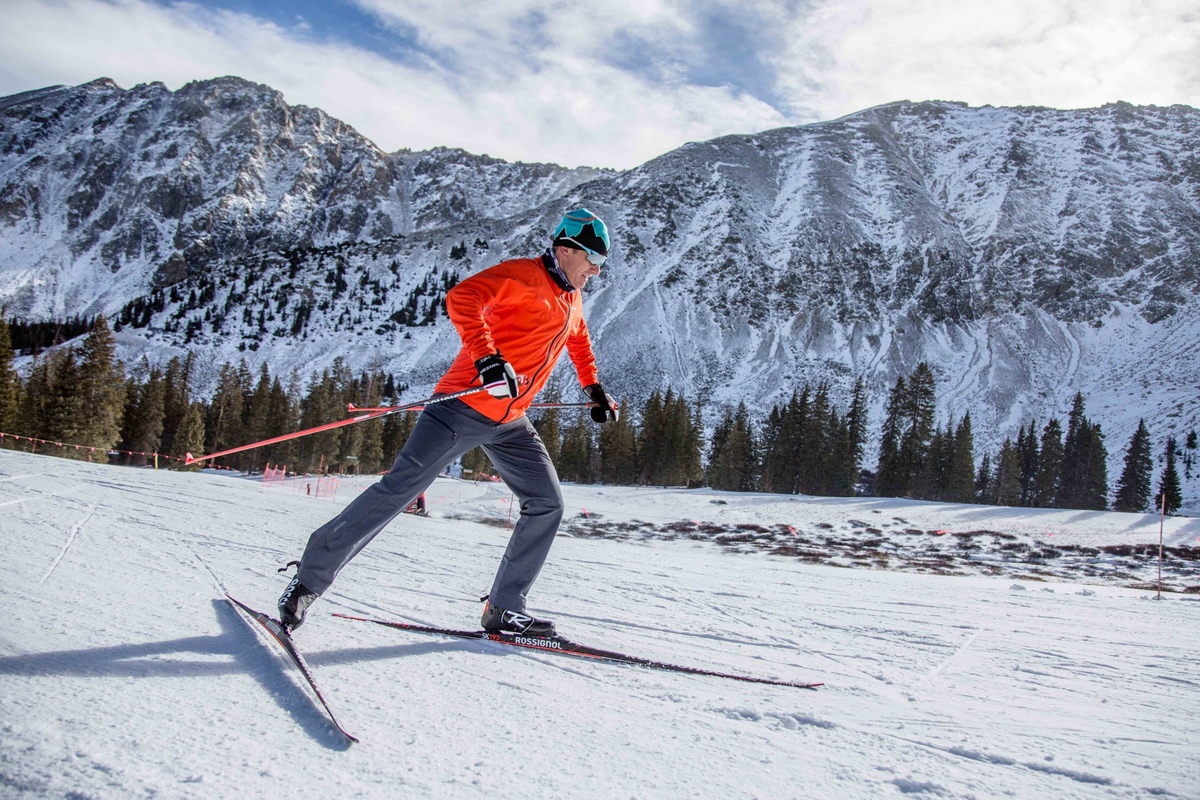

Featured
How To Skate Ski Cross Country
Modified: January 22, 2024
Learn how to skate ski cross country with our featured guide. Master the techniques and improve your speed and performance on the snow.
Introduction
Welcome to the exciting world of skate skiing! Whether you’re a seasoned cross-country skier or new to the sport, skate skiing offers an exhilarating and dynamic way to explore the winter landscape. If you’re looking for a full-body workout that combines cardiovascular endurance with stunning scenery, skate skiing is the perfect activity for you.
Skate skiing is a variation of classic cross-country skiing that mimics the motion of ice-skating. It involves a side-to-side motion, similar to the movement of a skater gliding across the ice. By using a technique known as the V-2 skate technique, skiers can propel themselves forward with speed and grace.
One of the great aspects of skate skiing is its versatility. Whether you prefer groomed tracks or breaking fresh powder, skate skiing can be enjoyed on various types of terrain. From flat, gentle slopes to challenging uphill climbs and thrilling downhill descents, skate skiing offers something for every skill level.
In this article, we will explore everything you need to know to get started with skate skiing. We’ll cover equipment selection, proper clothing and gear, mastering the basic techniques, and even delve into advanced techniques and tricks to take your skate skiing to the next level. Before we hit the slopes, let’s dive into finding the right equipment for your skate skiing adventure.
Choosing the Right Equipment
When it comes to skate skiing, having the right equipment is crucial for ensuring an enjoyable and safe experience on the slopes. Here are some key considerations when selecting your skate skiing gear:
- Skate Skis: Unlike classic cross-country skis, skate skis are shorter and stiffer. They have little to no grip on the base, allowing for smooth gliding and efficient propulsion. Look for skis that match your weight and skiing ability level. It’s also important to consider the ski’s flex, as a softer flex caters to beginners, while a stiffer flex is preferred by more advanced skiers.
- Bindings: Bindings play a critical role in connecting your ski boots to the skate skis. They should provide a secure fit, allow for proper flex in the ski, and offer easy entry and exit. Some bindings feature automatic step-in systems, while others require manual adjustment.
- Boots: Skate skiing boots are designed to provide ankle support and lateral stability. They should fit snugly but not be overly tight. Look for boots with good insulation and a comfortable inner lining to keep your feet warm and protected from the elements.
- Poles: Skate skiing poles are typically longer than classic cross-country ski poles. They should reach to your armpit level when standing upright. Look for poles that are lightweight, durable, and have ergonomic grips for a comfortable and efficient pole plant.
- Wax: Wax is applied to the base of the skate skis to optimize glide and control. There are different types of wax for different snow conditions, so it’s important to have a variety of waxes available to ensure optimal performance on different terrains and temperatures.
Remember, it’s always a good idea to consult with a knowledgeable ski shop or instructor when choosing your equipment. They can provide expert advice based on your skill level, terrain preferences, and budget. Additionally, consider renting equipment initially to get a feel for what works best for you before making any major purchases.
Proper Clothing and Gear
When engaging in any outdoor winter activity like skate skiing, proper clothing and gear are essential for your comfort, safety, and performance. Here are some guidelines to ensure you’re dressed appropriately for your skate skiing adventure:
- Layering: Layering is key to regulating your body temperature while skate skiing. Start with a moisture-wicking base layer that traps heat and keeps you dry. Add an insulating mid-layer, like a fleece or down jacket, for added warmth. Finally, wear a windproof and waterproof outer layer to protect against the elements.
- Headwear: Wear a hat or headband to keep your head warm and protect your ears from the cold. Consider a balaclava or neck gaiter to provide added protection for your face and neck.
- Gloves: Opt for gloves that are windproof and insulated to keep your hands warm. Consider mittens for extra warmth or liner gloves for added dexterity.
- Socks: Choose socks that are made of moisture-wicking material to keep your feet dry and prevent blisters. Look for socks that provide cushioning in key areas to enhance comfort and reduce fatigue.
- Eyewear: Protect your eyes from the sun’s glare and wind by wearing sunglasses or ski goggles. Make sure they have UV protection and are suitable for the lighting conditions on the slopes.
- Sun Protection: Even in winter, the sun’s rays can be powerful, especially when reflected off the snow. Apply sunscreen to exposed skin, especially to your face and any areas not covered by clothing.
- Backpack or Waist Pack: Consider carrying a small backpack or waist pack to store essentials like water, snacks, extra layers, and a basic repair kit.
Additionally, it’s important to wear clothing that allows for ease of movement. Choose fitted, stretchy layers that won’t restrict your range of motion. Avoid cotton clothing, as it retains moisture and can leave you feeling damp and cold.
By wearing the proper clothing and gear, you’ll stay comfortable, protected, and prepared for whatever the weather throws at you during your skate skiing adventures.
Mastering the Basic Techniques
Before hitting the slopes on your skate skis, it’s important to develop a solid foundation of basic techniques. Proper technique not only improves your efficiency and speed but also reduces the risk of injury. Here are the key elements to focus on while mastering the basic skate skiing techniques:
- Balance and Weight Transfer: Maintain a balanced and centered position on your skis. Shift your weight from ski to ski with each stride, transferring power and generating forward momentum.
- V-1 Technique: The V-1 technique is the foundation of skate skiing. In this technique, one ski glides forward while the other pushes off the snow with a diagonal stride. Focus on maintaining a symmetrical arm swing coordinated with your leg movements.
- V-2 Technique: The V-2 technique is used for increased speed and power. It involves a double-pole plant with each stride. As one ski glides forward, use both poles simultaneously to generate force and propel yourself forward.
- Glide and Edging: Pay attention to your glide by keeping your skis flat on the snow and maintaining a smooth, controlled motion. Practice edging your skis slightly to the side during the glide phase for better control and stability.
- Rhythm and Timing: Establish a rhythmic pattern with your strides and pole plants. Focus on timing your movements to maintain a steady pace and efficient energy transfer.
- Downhill Control: Learn proper techniques for controlling your speed and maintaining balance when descending slopes. Practice turning using edging and weight distribution to navigate downhill turns smoothly.
Building a strong foundation in these basic techniques will set you up for success and allow you to progress to more advanced maneuvers. Consider taking lessons from a certified instructor who can provide valuable feedback, correct any technique flaws, and help you reach your full potential on the slopes.
Remember, practice makes perfect. Dedicate consistent time to practicing these techniques, starting on flat terrain before progressing to more challenging slopes. With patience and persistence, you’ll become more confident and proficient in skate skiing.
Skate Skiing on Flat Terrain
Skate skiing on flat terrain provides the perfect opportunity to refine your techniques and build stamina. Here are some tips to maximize your efficiency and enjoyment on flat terrain:
- Start Slow: Begin by finding a flat and open area to practice. Focus on maintaining a steady rhythm and proper technique before increasing your speed.
- Push and Glide: Use the V-2 technique for flat terrain, where you push off with each ski and glide forward. Concentrate on generating power through your poles and transferring it to your skis for smooth and efficient gliding.
- Weight Transfer: Remember to shift your weight from ski to ski as you push and glide. This helps in maintaining balance and control while propelling yourself forward.
- Pole Timing: Coordinate your pole plants with your leg movements, ensuring that they occur as your ski pushes off. This synchronization boosts the effectiveness of your stride and helps maintain momentum.
- Pace Yourself: On flat terrain, focus on maintaining a consistent and sustainable pace. Find a rhythm that allows you to ski comfortably while still challenging yourself.
- Body Position: Keep your upper body tall and forward-leaning, engaging your core muscles for stability and control. Maintain a relaxed and balanced stance, with your knees slightly bent.
- Practice Turning: Experiment with different turning techniques, such as edging your skis and using your poles for support. Practicing smooth turns will enhance your control and agility on flat terrain.
- Track Etiquette: When skiing on groomed tracks or shared trails, be mindful of others around you. Stay to one side of the track to allow room for skiers to pass and communicate with others when overtaking or being overtaken.
Skate skiing on flat terrain is an excellent opportunity to fine-tune your skills and focus on technique. Remember to enjoy the experience and explore different flat routes to keep your skate skiing sessions fresh and exciting.
Skate Skiing on Uphill Terrain
Uphill skate skiing requires a combination of technique, strength, and endurance. Here are some tips to tackle uphill terrain with confidence and efficiency:
- Body Position: Lean forward slightly, engaging your core and driving your weight onto the balls of your feet. This position helps with maintaining balance and generating power during the ascent.
- Shorten Your Stride: Shorten your stride on uphill sections to conserve energy and maintain control. Focus on quick and powerful movements, pushing off the snow to propel yourself forward.
- V-1 Technique: On steeper uphills, employ the V-1 technique, where one ski glides forward while the other pushes off. Make sure to use your poles effectively to transfer power and maintain momentum.
- Weight Transfer: Shift your weight forward onto your pushing ski, so you can engage your muscles effectively and efficiently. This helps prevent the backward slide that can occur on uphill sections.
- Generate Power: Use your arms and poles to generate extra power on uphill climbs. Focus on a strong pole push and timing your poling with each stride to gain momentum and overcome the uphill resistance.
- Choose Proper Lines: Look for the smoothest and most gradual routes on uphill terrain. Avoid steeper sections that may cause you to lose momentum or become fatigued quickly.
- Steady Pace: Find a sustainable and consistent pace on uphill sections. Avoid starting too fast or pushing too hard too soon, as it can lead to burnout.
- Mental Focus: Uphill skiing requires mental perseverance. Stay focused, maintain a positive mindset, and break the climb into smaller sections to make it feel more manageable.
- Practice Interval Training: Incorporate interval training into your uphill skate skiing sessions. Alternate between short bursts of high-intensity climbing and recovery periods to build strength and endurance.
Remember, uphill skate skiing takes practice and patience. As you gain strength and hone your technique, you’ll become more efficient at conquering challenging inclines. Embrace the challenge, and enjoy the sense of accomplishment as you reach the summit.
Skate Skiing on Downhill Terrain
Skate skiing on downhill terrain can be an exhilarating and fun experience. Here are some tips to help you navigate downhill sections with control and confidence:
- Body Position: Adopt a slightly forward-leaning position to maintain balance and stability on the descent. Keep your knees slightly bent and your weight centered over your skis.
- Relax: Stay relaxed and allow your skis to glide freely down the slope. Tensing up or being overly rigid can hinder your control and limit your ability to react to changes in terrain.
- Edge Control: Use your edges to control your speed and direction while descending. By slightly angling your skis, you can increase or decrease your speed and make adjustments as needed.
- Weight Distribution: Distribute your weight evenly between both skis. This helps maintain stability and control during turns and maneuvers on downhill slopes.
- Turning: Practice turning techniques such as carving or skidding. Carving involves rolling your ankles and engaging your edges to make smooth, arcing turns. Skidding involves intentionally breaking the edges loose to slide sideways and control speed.
- Pole Use: Incorporate your poles in the turning process. Plant the pole on the side of the turn to help initiate and control your movements.
- Maintain Speed: To maintain speed and rhythm on longer downhill sections, use your poles to pole-push. This technique propels you forward and helps sustain your momentum.
- Stay Alert: Be aware of your surroundings and anticipate any changes in the terrain. Stay focused on the path ahead to react quickly and adjust your technique as needed.
- Practice Controlled Braking: Master the art of controlled braking by using the snowplow technique or edging your skis. This helps regulate your speed and maintain control on steeper downhill sections.
Remember to start on less challenging downhill terrain and gradually progress to steeper slopes as you build confidence and skill. As with any new techniques, practice is key. With time and experience, you’ll become more comfortable and proficient at skate skiing on downhill terrain.
Advanced Techniques and Tricks
Once you’ve mastered the basic techniques of skate skiing, you can explore advanced maneuvers and tricks to add style and excitement to your skiing. Here are some advanced techniques to take your skate skiing to the next level:
- Skate 2 Skis: This technique involves skating with both skis parallel to each other, generating power and speed. It requires strong core stability and precise timing of leg and arm movements.
- Double Poling: Double poling involves using both poles simultaneously to generate maximum power and speed. It requires strong upper body strength and coordination with leg movements.
- Jumps: Incorporate small jumps into your skate skiing routine to challenge your balance and control. Start with small bumps and gradually progress to larger jumps as your skills improve.
- 180-degree Turns: Practice executing 180-degree turns by using quick footwork and a strong pole plant. This technique allows you to change direction smoothly without losing momentum.
- Skating Backwards: Develop the ability to skate backwards by reversing your regular skate skiing technique. This skill can be useful for navigating tight spots or showing off your versatility on the slopes.
- Drafting: Take advantage of the aerodynamic effect by drafting behind a skier in front of you. This technique allows you to conserve energy while maintaining a fast pace.
- Skate-Ski Sprints: Challenge your speed and endurance by incorporating interval sprints into your skate skiing sessions. Alternate between short bursts of maximum effort and recovery periods.
- Lunges: Practice incorporating lunges into your skate skiing routine. This advanced technique helps with balance, strength, and stability and can be particularly effective when skiing uphill.
- Off-Piste Skiing: Venture off groomed tracks and explore ungroomed backcountry terrain. Off-piste skate skiing allows you to navigate through untouched snow and explore new and challenging routes.
- Combining Classic and Skate Techniques: For added versatility, learn to combine classic cross-country skiing techniques with skate skiing techniques. This allows you to adapt to different terrains and snow conditions.
Remember, advanced techniques require practice, patience, and a willingness to step out of your comfort zone. As you continue to refine your skills, have fun experimenting with these tricks to enhance your skate skiing experience.
Common Mistakes to Avoid
When it comes to skate skiing, avoiding common mistakes can greatly improve your technique and overall experience on the slopes. Here are some pitfalls to watch out for:
- Leaning Back: One of the most common mistakes is leaning back, which leads to a loss of balance and control. Remember to maintain a slightly forward-leaning position to stay balanced and generate power.
- Incorrect Pole Timing: Mistiming your pole plants can disrupt your rhythm and throw off your stride. Practice coordinating your pole plants with your leg movements for optimal power and efficiency.
- Insufficient Weight Transfer: Failing to shift your weight properly between skis can result in poor glide and less effective propulsion. Focus on transferring your weight smoothly from ski to ski with each stride.
- Overstriding: Extending your legs too far forward, known as overstriding, can lead to loss of balance and strain on your muscles. Maintain a controlled stride length that allows for a strong push-off and proper weight transfer.
- Lack of Upper Body Engagement: Neglecting to use your upper body, particularly your arms and core, can result in a loss of power and momentum. Remember to engage your entire body in the skate skiing motion for efficient propulsion.
- Poor Glide Technique: Failing to maintain a proper glide can make skate skiing feel laborious and inefficient. Focus on keeping your skis flat on the snow, with a controlled and smooth gliding motion.
- Ignoring Trail Etiquette: Not adhering to trail etiquette can lead to frustration and potential accidents. Be aware of your surroundings, communicate with fellow skiers, and follow any posted guidelines or rules.
- Incorrect Equipment Setup: Using improperly fitted or adjusted equipment can hinder your performance and increase the risk of injury. Ensure that your boots, skis, and bindings are correctly sized and adjusted for your skill level and skiing style.
- Skipping Warm-up and Stretching: Neglecting to warm up your body and stretch before skate skiing can increase the risk of muscle strains or pulls. Prioritize a warm-up routine and gentle stretching to prepare your muscles for the activity.
- Overlooking Technique Refinement: Skate skiing is a sport that requires continual refinement of technique. Don’t get complacent with your skills; seek opportunities for improvement through lessons or practice sessions.
By being aware of these common mistakes and actively working to avoid them, you can enhance your skate skiing experience, improve your technique, and prevent unnecessary setbacks or injuries.
Safety Tips for Skate Skiing
Skate skiing is a thrilling and enjoyable winter activity, but it’s important to prioritize safety while out on the slopes. Here are some essential safety tips to keep in mind:
- Equipment Check: Before you start, ensure that all your equipment is in good condition. Check the bindings, poles, and skis for any signs of damage or wear and tear.
- Know Your Limits: Be honest about your skill level and choose trails and terrain that match your abilities. Pushing beyond your capabilities can lead to accidents and injuries.
- Stay Hydrated: It’s easy to overlook hydration during cold weather, but it’s important to stay hydrated while skate skiing. Drink water before, during, and after your session to keep your body properly fueled.
- Be Aware of Weather Conditions: Check the weather forecast before heading out and be prepared for changes in weather conditions. Dress in layers and make adjustments to your skiing plans if needed.
- Observe Trail Rules and Etiquette: Respect and follow the rules and guidelines of the trails you’re skiing on. Yield to other skiers, be aware of your surroundings, and communicate with fellow skiers when needed.
- Use Proper Sun Protection: Even on cloudy days, the sun’s rays can still be damaging. Apply sunscreen to exposed areas of skin and wear sunglasses or ski goggles with UV protection to shield your eyes.
- Stay on Designated Trails: Stick to marked trails and avoid venturing into closed or restricted areas. Going off-piste can increase the risk of accidents and danger.
- Plan Ahead and Inform Others: Let someone know your skate skiing plans, including the trail you’ll be on and your estimated return time. In the event of an emergency, this information can be crucial.
- Carry Essential Safety Gear: Carry a small backpack or waistpack with essentials such as a map, compass, first aid kit, extra clothing layers, food, water, and a mobile phone for emergencies.
- Take Lessons and Continue to Learn: Invest in lessons from a certified instructor to learn proper technique and safety practices. Continuously improving your skills will enhance enjoyment and reduce the risk of accidents.
- Be Mindful of Wildlife: Respect the natural environment and wildlife around you. Avoid disturbing or approaching animals and be mindful of their habitats.
Remember, safety should always be a top priority when engaging in any outdoor activity. By incorporating these safety tips into your skate skiing routine, you can have a fun and safe experience on the slopes.
Conclusion
Skate skiing provides a fantastic opportunity to explore the winter wonderland while getting a full-body workout. By choosing the right equipment, wearing proper clothing, and mastering the basic techniques, you’ll be well on your way to enjoying the exhilaration and freedom of skate skiing.
From flat terrain to uphill climbs and downhill descents, skate skiing offers a variety of challenges and rewards. By avoiding common mistakes, incorporating advanced techniques, and prioritizing safety, you can progress as a skate skier while minimizing the risk of injury.
Remember, skate skiing is a lifelong learning experience. Continuously refine your technique, seek opportunities for growth, and be open to trying new tricks and maneuvers. Whether you’re a beginner or an advanced skier, there’s always something new to discover on the slopes.
So strap on your skis, glide across the snow, and let the thrill of skate skiing propel you to new heights. Enjoy the beauty of the winter landscape, the rush of speed, and the sense of accomplishment that comes from pushing yourself and exploring new trails.
Embrace the adventure of skate skiing, and may your experiences on the slopes bring you joy, fitness, and a deeper appreciation for the wonders of winter.
